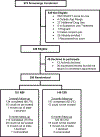Computer- vs. nurse practitioner-delivered brief intervention for adolescent marijuana, alcohol, and sex risk behaviors in school-based health centers
- PMID: 33307377
- PMCID: PMC10329852
- DOI: 10.1016/j.drugalcdep.2020.108423
Computer- vs. nurse practitioner-delivered brief intervention for adolescent marijuana, alcohol, and sex risk behaviors in school-based health centers
Abstract
Background: This study examined approaches to delivering brief interventions (BI) for risky substance use and sexual behaviors in school-based health centers (SBHCs).
Methods: 300 Adolescents (ages 14-18; 54 % female) with risky marijuana and/or alcohol use identified via CRAFFT screening (scores >1) were recruited from two SBHCs and randomized to computer-delivered BI (CBI) or nurse practitioner-delivered BI (NBI). Both BIs included motivational and didactic content targeting marijuana, alcohol, and risky sexual behaviors. Assessments at baseline, 3-month, and 6-month follow-up included past 30-day frequency of marijuana use, alcohol use, binge drinking, unprotected sex, and sex while intoxicated; marijuana and alcohol problems; and health-related quality-of-life (HRQoL). A focused cost-effectiveness analysis was conducted. An historical 'assessment-only' cohort (N=50) formed a supplementary quasi-experimental comparison group.
Results: There were no significant differences between NBI and CBI on any outcomes considered (e.g., days of marijuana use; p=.26). From a cost-effectiveness perspective, CBI was 'dominant' for HRQoL and marijuana use. Participants' satisfaction with BI was significantly higher for NBI than CBI. Compared to the assessment-only cohort, participants who received a BI had lower frequency of marijuana (3-months: Incidence Rate Ratio [IRR] = .74 [.57, .97], p=.03), alcohol (3-months: IRR = .43 [.29, .64], p<.001; 6-months: IRR = .58 [.34, .98], p = .04), alcohol-specific problems (3-months: IRR = .63 [.45, .89], p=.008; 6-months: IRR = .63 [.41, .97], p = .04), and sex while intoxicated (6-months: IRR = .42 [.21, .83], p = .013).
Conclusions: CBI and NBI did not yield different risk behavior outcomes in this randomized trial. Supplementary quasi-experimental comparisons suggested potential superiority over assessment-only. Both NBI and CBI could be useful in SBHCs.
Keywords: Alcohol; Brief intervention; Marijuana; School-based health centers; Sexual health.
Copyright © 2020 Elsevier B.V. All rights reserved.
Conflict of interest statement
Conflicts of Interest
The authors report no conflicts of interest.
Figures

Similar articles
-
Sexually Transmitted Infection Testing After Brief Intervention for Risk Behaviors in School-Based Health Centers.J Adolesc Health. 2022 Apr;70(4):577-583. doi: 10.1016/j.jadohealth.2021.11.013. Epub 2022 Jan 22. J Adolesc Health. 2022. PMID: 35078735 Clinical Trial.
-
Therapist and computer-based brief interventions for drug use within a randomized controlled trial: effects on parallel trajectories of alcohol use, cannabis use and anxiety symptoms.Addiction. 2020 Jan;115(1):158-169. doi: 10.1111/add.14781. Epub 2019 Oct 24. Addiction. 2020. PMID: 31400240 Free PMC article. Clinical Trial.
-
Recovery schools for improving behavioral and academic outcomes among students in recovery from substance use disorders: a systematic review.Campbell Syst Rev. 2018 Oct 4;14(1):1-86. doi: 10.4073/csr.2018.9. eCollection 2018. Campbell Syst Rev. 2018. PMID: 37131375 Free PMC article.
-
Screening and brief intervention for alcohol and other abuse.Adolesc Med State Art Rev. 2014 Apr;25(1):126-56. Adolesc Med State Art Rev. 2014. PMID: 25022191 Review.
-
Risky business: risk behaviors in adolescents with type 1 diabetes.Diabetes Educ. 2011 Nov-Dec;37(6):756-64. doi: 10.1177/0145721711422610. Epub 2011 Oct 14. Diabetes Educ. 2011. PMID: 22002971 Free PMC article. Review.
Cited by
-
Health-promotion interventions targeting multiple behaviors: A meta-analytic review of general and behavior-specific processes of change.Psychol Bull. 2024 Jul;150(7):798-838. doi: 10.1037/bul0000427. Epub 2024 Jun 24. Psychol Bull. 2024. PMID: 38913732 Free PMC article. Review.
-
The Perceived Benefits of Digital Interventions for Behavioral Health: Qualitative Interview Study.J Med Internet Res. 2022 Mar 30;24(3):e34300. doi: 10.2196/34300. J Med Internet Res. 2022. PMID: 35353045 Free PMC article.
-
Technology-Based Interventions for Substance Use Treatment Among People Who Identify as African American or Black, Hispanic or Latino, and American Indian or Alaska Native: Scoping Review.J Med Internet Res. 2024 Dec 3;26:e53685. doi: 10.2196/53685. J Med Internet Res. 2024. PMID: 39626234 Free PMC article.
-
Integration of an Electronic Screening, Brief Intervention, and Referral to Treatment Program Into an HIV Testing Program to Reduce Substance Use and HIV Risk Behavior Among Men Who Have Sex With Men: Protocol for Intervention Development and a Pilot Randomized Controlled Trial.JMIR Res Protoc. 2024 Mar 14;13:e56683. doi: 10.2196/56683. JMIR Res Protoc. 2024. PMID: 38483463 Free PMC article.
-
Primary Prevention of Drug Overdoses in Rural Low-Resource and Tribal Communities: A Cluster Randomized Trial.Am J Public Health. 2025 Sep;115(9):1508-1517. doi: 10.2105/AJPH.2025.308205. Am J Public Health. 2025. PMID: 40768695 Clinical Trial.
References
-
- Alayan N, Shell L, 2016. Screening adolescents for substance use: The role of NPs in school settings. Nurse Pract 41(5), 1–6. - PubMed
-
- Borenstein M, Cohen J, 1988. Statistical power analysis. L. Erlbaum Associates, Hillsdale, NY.
-
- Brazier JE, Roberts J, 2004. The estimation of a preference-based measure of health from the SF-12. Med Care 42(9), 851–859. - PubMed
-
- Briggs AH, Claxton K, Sculpher MJ, 2006. Decision Modelling for Health Economic Evaluation. Oxford University Press, USA.
-
- Cohen J, 1988. Statistical power analysis for the behavioral sciences, 2nd ed. L. Erlbaum Associates, Hillsdale, N.J.
Publication types
MeSH terms
Grants and funding
LinkOut - more resources
Full Text Sources
Other Literature Sources
Medical
Miscellaneous

